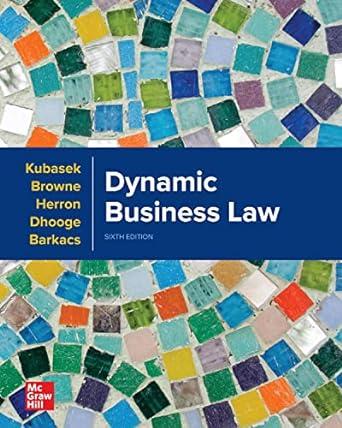Question
From Torts, we turn to Criminal Law. A tort is a wrong committed by one person against another, causing damage. Meanwhile, a crime occurs when
From Torts, we turn to Criminal Law. A tort is a wrong committed by one person against another, causing damage. Meanwhile, a crime occurs when an individual violates a criminal statute that prohibits and punishes certain conduct. For example, a verdict of not-guilty in a criminal assault or battery case does not prevent victims from filing a civil suit for the same action. In other words, a person can be found civilly liable and be forced to pay damages arising out of the same incident, even if they are not convicted (i.e., found not guilty) of a crime. This is what happened when a civil court awarded a $33.5 million judgment in compensatory and punitive damages against O.J. Simpson, despite the fact that he was not convicted for the crime of murder. (On page 231, your book provides that "Not Guilty Might Not Mean Innocent" in reference to the O.J. Simpson trial.)
In many respects, the underlying purpose of both are similar. Both tort law and criminal law are used to identify and take actions against wrongdoers as well as to deter future wrongs from occurring. If the focus of tort law is what a victim can do about harm that the victim has suffered, then the respective focus of criminal law is on the person who commits a crime. Although crimes often have immediate victims, the ultimate victim of crime isby and in largesociety.
Given that, consider the following -
On March 4, 2020, California Governor Gavin Newsom declared a state of emergency. Skim his declaration:10A Governor State of Emergency Declaration.pdf
On March 4, 2020, California Attorney General Xavier Becerra issued a consumer alert about Penal Code Section 396. Read the consumer alert:10B Attorney General Press Release.pdf
Read also the Memo of the U.S. Attorney General to U.S. Attorneys:10C DOJ Memo of the U.S. Attorney General to U.S. Attorneys.pdf
- Based on these readings, define price gouging in the context of COVID-19.
- What was the intention of the state legislature, or the "legislative intent," behind the drafting of Penal Code Section 396?
- On April 3, 2020, California Governor Gavin Newsom issued an executive order to thwart price gouging in the context of COVID-19. Skim and analyze:10E Governor Executive Order N-44-20.pdf.In what ways did the Governor try to extend Section 396 in issuing his executive order?
- Analyze the two examples - On May 25, 2020, an individual was charged with hoarding and price gouging N95 masks. Then-U.S. Attorney for the Southern District of New York GeoffreyBerman provided that the criminal defendant allegedly spent over $200,000 to accumulate masks to sell at inflated prices. Read:10F ICE Criminal Charge for Hoarding N95 Masks.pdf On April 7, 2020, investigators seized 50,000 masks from a warehouse located off Warm Springs Boulevard in Fremont, with the individual being issued a citation. No charges were ultimately filed. Read:10G Warm Springs Masks Seized.pdf Determine the key differences between the case in Warm Springs and the case in New York. Specifically, one was charged with price gouging with respect to N95 masks, while the other was not. Why is that?
Step by Step Solution
There are 3 Steps involved in it
Step: 1

Get Instant Access to Expert-Tailored Solutions
See step-by-step solutions with expert insights and AI powered tools for academic success
Step: 2

Step: 3

Ace Your Homework with AI
Get the answers you need in no time with our AI-driven, step-by-step assistance
Get Started


